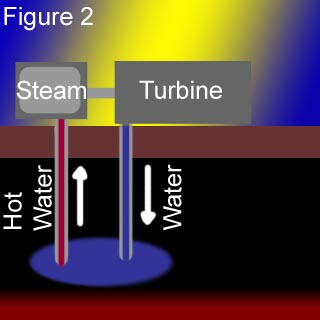Site Navigation
Introduction
What is geothermal energy?
Using Geothermal Energy
Using Geothermal Energy
Geothermal Technologies
Conclusion
Is geothermal energy practical?
References
Bibliography of Sources

USING GEOTHERMAL ENERGY
There exist several methods by which to convert geothermal energy to usable forms of energy. Within the traditional method of using geothermal energy - by tapping reservoirs of heated water – there are three primary methods for generating electricity. The methods are as follows:
Using Steam
This method is the same as the one described on the “What is Geothermal Energy” page; it uses the naturally – produced steam of a tapped geothermal reservoir. In this method, the superheated water of a geothermal reservoir changes phases, becoming steam, and rises through a pipe to the earth’s surface, where it is used to turn a turbine and produce electricity. This method is the simplest way to use geothermal energy, since it requires no processing of or interference with the geothermal reservoir. (See figure 1)

Improving Upon Steam
The performance of a geothermal plant may be improved by transporting the reservoir’s water – in liquid form – to the surface. The water, often in excess of “360 degrees Fahrenheit” (REPP-CREST), is pumped into an expansion chamber near the turbine, where it responds to the lower pressure – in comparison to the underground reservoir – by “flashing” into steam. The steam is then used to drive a turbine, as in previous method. This method offers several advantages; it is more efficient, since it is easier to draw water from the reservoir than it is to draw steam, and the flash-conversion of the water to steam yields a greater amount of energy than does the conventional steam technique. As in the previous method, the steam is condensed and returns to the reservoir after it drives the turbine.

Using a Closed System
The above system can be further improved by using a closed system, one in which the steam from the geothermal reservoir does not come into contact with the plant’s turbines. Instead, hot water from the geothermal reservoir is pumped into a heat exchanger, a device that transfers the water’s heat to another liquid. The other liquid, called a “working liquid,” boils as a result of the heat transfer, and its steam is used to turn the plant’s turbines. (See Figure 3)
Closed-system geothermal plants hold several advantages over the other methods. By using a “working liquid” with a low boiling point, the plant can operate using lower-temperature geothermal reservoirs, making it more versatile. Furthermore, separating the two liquids – the working liquid and the water from the reservoir – prevents contamination of the reservoir, while greatly reducing emissions of sulfur, CO2, and other gasses.
